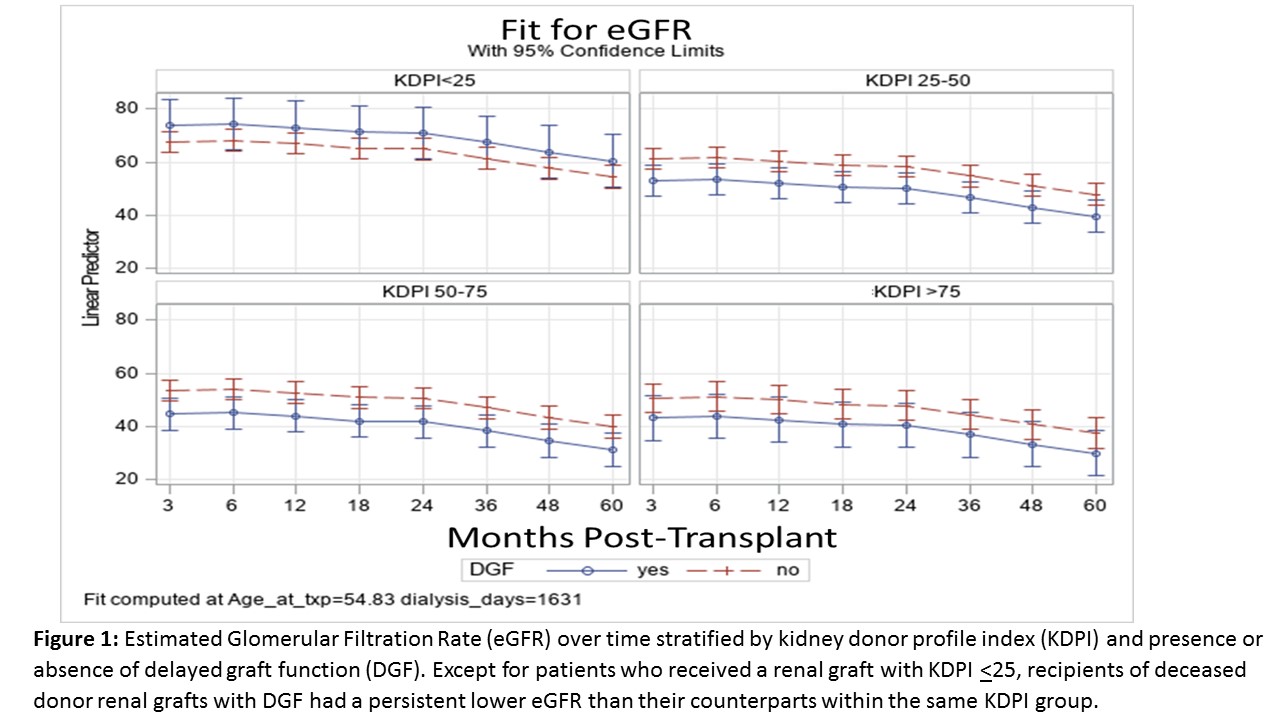The Effects of DGF after Deceased Donor Renal Transplantation Differ by KDPI
1Surgery, University of Pittsburgh Medical Centre, Pittsburgh, PA, 2Biostatistics, University of Pittsburgh Medical Centre, Pittsburgh, PA, 3Medicine, University of Pittsburgh Medical Centre, Pittsburgh, PA
Meeting: 2020 American Transplant Congress
Abstract number: 352
Keywords: Glomerular filtration rate (GFR), Graft function, Graft survival, Survival
Session Information
Session Name: Kidney Complications: Non-Immune Mediated Late Graft Failure
Session Type: Oral Abstract Session
Date: Saturday, May 30, 2020
Session Time: 3:15pm-4:45pm
 Presentation Time: 4:03pm-4:15pm
Presentation Time: 4:03pm-4:15pm
Location: Virtual
*Purpose: We analyzed the effects of DGF on: (1) graft survival, (2) patient survival and (3) eGFR of adult recipients of deceased donor kidney transplants stratified by KDPI
*Methods: Recipients transplanted between January 2013-December 2018 at our center were included. Multiorgan transplants were excluded. Patients were stratified into four groups: group I (KDPI <25, n=196), group II (KDPI 26-50, n=215), group III (KDPI 51-75, n=207) and group IV (KDPI >76, n=103). Patients were followed till October 2019. Serum creatinine and eGFR were obtained at 3, 6, 12, 18, 24, 36, 48, and 60 months. Creatinine levels of recipients who resumed dialysis was set at 8 mg/dL. Impending graft loss was defined as eGFR<20 ml/min. Kaplan-Meier functions were used to estimate patient survival and death-censored graft loss. Relationships between eGFR, KDPI group and DGF were evaluated by linear mixed models adjusting for recipient age and dialysis duration. Comparisons were performed across groups and stratified by DGF.
*Results: 721 patients were included, and 170 (23.6%) developed DGF. DGF occurred in 9.7% of group I, 28.8% of group II, 28% of group III, and 30.1% of group IV (p for trend <0.001). Except for group I, eGFR remained persistently lower in DGF (+) compared to DGF (-) recipients with a mean difference of -8.25 ml/min for group II (P=0.02), -8.8 ml/min (P=0.01) for group III and -7.6 ml/min (P<0.0001) for group IV (Figure 1). Both KDPI and DGF were significant predictors of eGFR (p<0.0001 and p=0.04 respectively). The interaction between DGF and KDPI was tested but did not reach statistical significance (p=0.09). Patient survival across groups and within each group between DGF (+) and DGF (-) patients were not statistically different. On the other hand, compared to group I (reference), group III (P=0.01) and group IV (P=0.04), had a significant higher risk of death-censored graft loss irrespective of DGF. Also, compared to group I, recipients in group IV had a higher risk of graft-loss and impeding graft loss (P=0.05 for DGF (+) recipients and P=0.03 for DGF (-) recipients).
*Conclusions: 1. The eGFR of DD kidney transplants is inversely proportional to KDPI. 2. There are no long-term negative effects of DGF for grafts with KDPI <25. 3. On the other hand, DGF has persistent negative effects on eGFR for KDPI>25. 4. There is a significant increase in death-censored graft loss and impending graft loss for recipients of grafts with KDPI>50 and who develop DGF.
To cite this abstract in AMA style:
Molinari M, Chang W, Jorgensen D, Wu C, Hariharan S. The Effects of DGF after Deceased Donor Renal Transplantation Differ by KDPI [abstract]. Am J Transplant. 2020; 20 (suppl 3). https://atcmeetingabstracts.com/abstract/the-effects-of-dgf-after-deceased-donor-renal-transplantation-differ-by-kdpi/. Accessed December 20, 2025.« Back to 2020 American Transplant Congress

